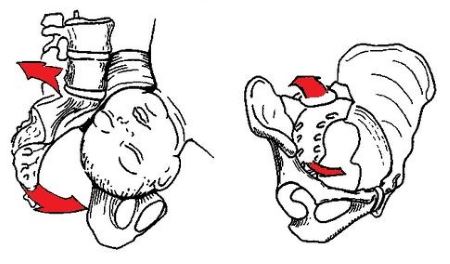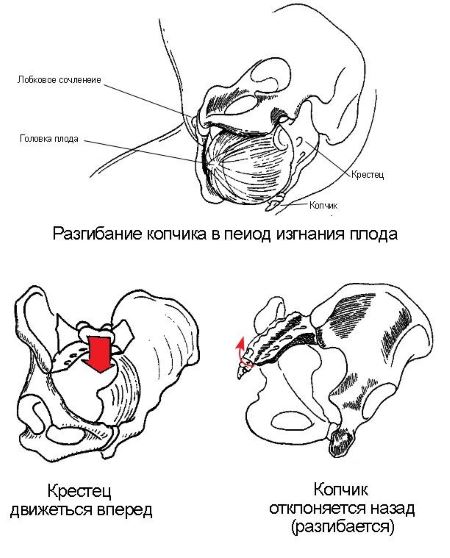Causes severe pain in the coccyx after birth
Scientific name for pain in the coccyx – kokcigodiniâ. The word comes from the Greek "kokciks" and accurately displays the problem. From pain in this area three times more often affects women. Such statistics is that they are injured tailbone after not only falling but also during pregnancy and childbirth.
The lower part of the spine consisting of five fused bones called coccyx. OK – this is almost a fixed site, capable of flexion and extension. Abnormal mobility of the vertebrae is the deviation angle that is less than 30 degrees, and rotate by a quarter circle is considered a dislocation.
Causes and risk factors coccygodynia
The Cause of pain in the coccyx after birth becomes damage or entrapment of spinal nerves.
The Problem occurs more often in women who before pregnancy had suffered:
- osteochondrosis
- scoliosis
- inflammatory diseases
- a chamber;
- depression;
- from a tailbone injury
- from the lack of calcium.
To coccygodynia predisposed lover sedentary lifestyle. The risk increases in women who are accustomed to sit with tightened to the stomach feet.
Mechanism of damage to the tailbone during childbirth
During pregnancy the pelvic bones diverge to accommodate the fetus. At this point, the tailbone feels a certain pressure, the force of which is greater, the larger the child.
At birth, when the head is entering the pelvis, the sacrum moves back and the tailbone forward. Experience the phenomenon of bending. With further progress in the fetus sacrum back into place, and tailbone moving freely.


If all these processes are natural, why do injuries occur? The fact that unique not only every woman but also every pregnancy. The health of future mothers and the flow of labor depend on:
- structure of the pelvis;
- General health
- fruit size
- presentation and position of fetus;
- force powers
- the rate of passage of the fetus through the birth canal.
Each of the above factors and their combination can cause complications and injuries. For stretching the Sacro-coccygeal ligament, dislocation, displacement or fracture of the coccyx enough of a combination of a narrow pelvis, a large fetus, breech previa.
In the process of rapid childbirth pelvic bones do not have time to take the appropriate position, and therefore the possible dislocation and displacement of the coccyx and sprain.
Why kokcigodiniâ sometimes develops in women undergoing caesarean section?
In this case the cause may be:
- tailbone injury received before pregnancy;
- the curvature of the spine;
- lack of calcium in the body;
- large fruit.
All these factors act during pregnancy. When a woman experiences persistent pain in the coccyx area, the intensity of which does not change after birth.
Symptoms of postpartum pain in tailbone
Pain in the coccyx after birth is perceived as normal, if it lasts 3 weeks. During this time the bones of the pelvis return to a normal position.
If a woman after a three-week period concerned about a sharp pain in the sitting position, worse when lifting, you should consult a doctor. Adverse symptom will be:
- pain during defecation or sexual intercourse;
- pain radiating to the perineum or buttocks;
- numbness of the coccyx;
- hematoma and edema in the coccyx area;
- shot in the thigh
- inability to walk quickly.
The Tension of the Sacro-coccygeal ligament causes spasm of the Piriform and gluteal muscles. Because this is not always the pain is the exact place of localization and the same character. Problems can arise when the slopes and lifts of the torso. Spasm of the piriformis sometimes becomes the cause of infringement of the sciatic nerve.
Postpartum swelling and discomfort may mask the symptoms of a tailbone injury. If inflammation of the soft tissues is removed, and the pain in the buttocks continues to bother you, you should consult a doctor.
Diagnosis
Pain in the pelvic area caused by various reasons, but can be similar in nature. Therefore, if the diagnosis of the trauma surgeon or a neurologist would be useful to know the opinion of gynecologist, surgeon and proctologist. The doctors will discern coccygodynia from radicular syndrome, neuralgia of the rectum, chronic colitis, cystitis, adnexitis, endometritis or hemorrhoids.
At First, the doctor will conduct a clinical examination of the patient on the gynecological chair and in the knee-elbow position. Listens to complaints, establish the history of the development of the disease. The fact of the fracture can be identified by examination through the rectum or pressing on the coccyx from the outside. If the patient has a sore tailbone, pressing it will experience increased pain.
"On coccygodynia indicates pain in a sitting position, its localization inthe area of autonomic fibers coccygeal plexus."
Specialists require ultrasound examination or x-ray methods of diagnosis. Usually do an x-ray, MRI or CT. Up to 40% of cases, coccygodynia is detected before the x-rays.
Treatment, prevention and possible complications
Pain in the coccyx after birth are most often treated with conservative method. A specific set of therapeutic techniques prescribed by a doctor. They will be selected depending on the nature and duration of trauma.
As a measure of first aid in case of swelling of the coccyx it is recommended to apply cold. If the pain disturbing for a long time, it is possible to remove discomfort can mild warmth. The circulation in the painful area is strengthened through the friction irritating tinctures (bertsovoj, lilac).
It is Recommended to avoid prolonged sitting with the back tilted back. Instead, it is better to master a pose with back bend forward and focusing on the elbows or "the pose of the little Mermaid". As subsidiary means for the seat use a roll of towels, a rubber ring or special orthopedic pillow. During treatment should avoid lifting and carrying heavy objects.
Sprains and fractures are corrected by trauma. In fractures of the patient is recommended bed rest.
Pain when stretching the Sacro-coccygeal ligaments treated with exercise. A set of exercises selected by the trauma. The first classes are conducted under the guidance of coach.
The Relaxation of the gluteal muscles is achieved massage and reflexology.
Physiotherapy is prescribed:
- pulse currents
- UHF
- laser therapy
- ultrasound procedures;
- paraffin baths.
Withdrawal symptoms of postpartum coccygodynia medication is justified only in cases of severe pain, as nursing mothers are contraindicated to take painkillers in the form of tablets or ointments. The decision to appoint analgesics or NSAIDs the physician makes.
Surgery for coccygodynia after confinement is used very rarely. Mainly it is used if conservative treatment does not help the state. Resection is only subjected to the moving part of the coccyx.
Postpartum kokcigodiniâ often passes without complications within 3 to 4 weeks after birth. The exceptions are fractures, displacement or dislocation of the coccyx, left untreated. At the site of fracture callus is formed, which will greatly disturb the rest of your life.
To avoid injury during pregnancy and childbirth, you should prefer active way of life instead of a long cheer at the TV or at the computer. To have a child you should be prepared, replenishing the body with calcium and vitamins. Healthy spine, the trained muscles and strong bones will guarantee against the development of postpartum coccygodynia.
Further reading:
- Shukhov B. C. safety of self-medication ("over-thecounter" analgesics / NSAIDs") // Int. honey. log. – 2000. – No. 3. – P. 265-268.










